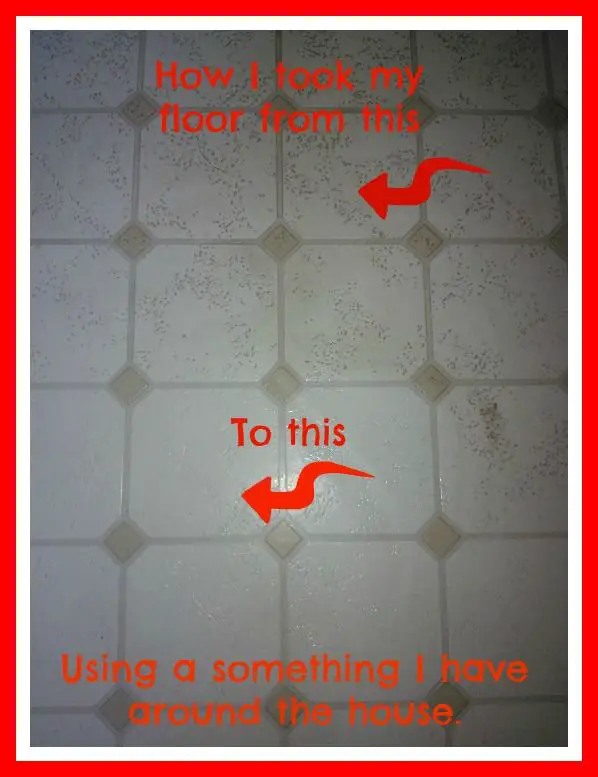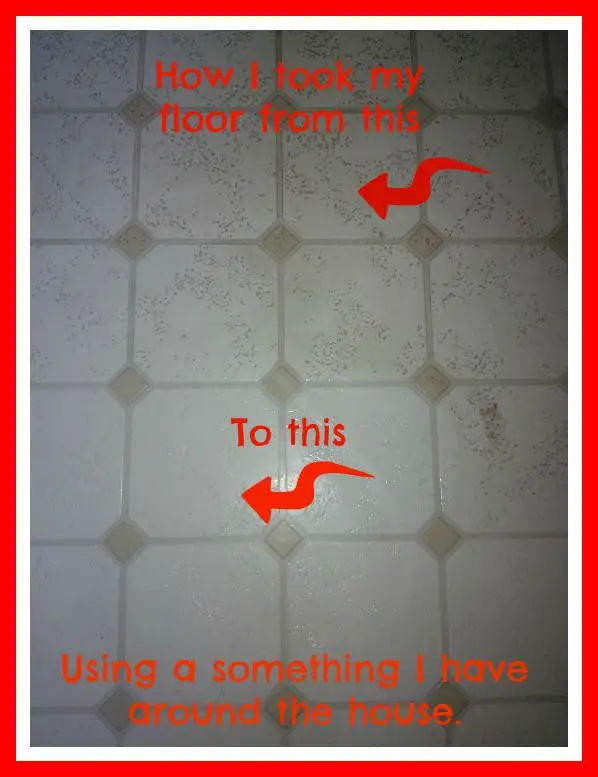Are you tired of using harsh chemicals to clean your linoleum floors? Look no further than hydrogen peroxide! This versatile and effective cleaning solution can easily remove dirt, stains, and grime without damaging your floors. In this guide, we will show you how to clean linoleum floors with hydrogen peroxide, making your cleaning routine a breeze.
Hydrogen peroxide is a safer and more eco-friendly alternative to traditional cleaning products, making it a popular choice for many homeowners. Not only is it effective at cleaning linoleum floors, but it also has antibacterial properties, making it a great option for households with pets or young children. So, let’s get started on learning how to clean your linoleum floors with hydrogen peroxide!
- First, sweep or vacuum the floor to remove any loose debris.
- Mix equal parts of hydrogen peroxide and water in a spray bottle.
- Spray the solution onto the linoleum floor and let it sit for 5-10 minutes.
- Scrub the floor with a soft-bristled brush or sponge.
- Rinse the floor with clean water and dry it with a clean cloth.
- For tough stains, mix baking soda and water to make a paste and apply it to the stain. Let it sit for 5-10 minutes before scrubbing and rinsing.

How to Clean Linoleum Floors with Hydrogen Peroxide – A Comprehensive Guide
Cleaning linoleum floors can be a daunting task, especially when it comes to removing stubborn stains and grime. While there are many cleaning solutions available in the market, one of the most effective and affordable cleaning agents is hydrogen peroxide. It not only helps to remove tough stains but also acts as a disinfectant, making it an ideal choice for cleaning linoleum floors. In this article, we will discuss in detail how to clean linoleum floors with hydrogen peroxide.
Understanding Linoleum Floors
Before we dive into the cleaning process, it is essential to understand what linoleum floors are and how they differ from other flooring options. Linoleum floors are made from natural raw materials such as linseed oil, wood flour, and pine resin, making them an eco-friendly and sustainable flooring option. Unlike vinyl floors, which are synthetic, linoleum floors are biodegradable and do not emit harmful gases.
The Benefits of Cleaning with Hydrogen Peroxide
Hydrogen peroxide is a versatile cleaning agent that has many benefits when it comes to cleaning linoleum floors. Here are some of the benefits:
Effective Stain Removal
Hydrogen peroxide is a powerful stain remover that can help remove stubborn stains from linoleum floors, such as coffee, tea, and wine stains.
Natural Disinfectant
Hydrogen peroxide is a natural disinfectant that can help kill germs and bacteria on linoleum floors, making it a safe and effective cleaning agent.
Environmentally Friendly
Hydrogen peroxide is an environmentally friendly cleaning agent that is non-toxic and biodegradable, making it a safe choice for the environment and your family.
How to Clean Linoleum Floors with Hydrogen Peroxide
Now that we have discussed the benefits of using hydrogen peroxide let’s dive into the cleaning process. Here are the steps to clean linoleum floors with hydrogen peroxide:
Step 1: Sweep or Vacuum the Floor
Before you begin cleaning, ensure that you sweep or vacuum the floor to remove any loose dirt and debris.
Step 2: Mix the Cleaning Solution
Mix 1 cup of hydrogen peroxide with 1 gallon of warm water in a bucket.
Step 3: Apply the Cleaning Solution
Using a mop or a cleaning cloth, apply the cleaning solution to the linoleum floor in sections.
Step 4: Scrub the Floor
Using a scrub brush or a hard-bristled broom, scrub the floor gently in circular motions to remove any stubborn stains or grime.
Step 5: Rinse the Floor
After scrubbing, rinse the floor thoroughly with clean water to remove any cleaning solution residue.
Step 6: Dry the Floor
Using a clean, dry cloth, dry the floor thoroughly to prevent any water damage.
Hydrogen Peroxide vs. Other Cleaning Agents
When it comes to cleaning linoleum floors, hydrogen peroxide has several advantages over other cleaning agents. Here is a comparison:
Hydrogen Peroxide vs. Vinegar
While vinegar is a popular cleaning agent, it is not as effective as hydrogen peroxide when it comes to removing tough stains and grime from linoleum floors.
Hydrogen Peroxide vs. Bleach
Bleach is a powerful cleaning agent that can help remove stains and disinfect surfaces. However, it is not safe to use on linoleum floors as it can cause discoloration and damage to the flooring.
Conclusion
Cleaning linoleum floors with hydrogen peroxide is an effective and affordable way to keep your floors clean and germ-free. With the steps outlined in this article, you can easily clean your linoleum floors and enjoy a clean and healthy home. Remember to always test the cleaning solution in a small, inconspicuous area before cleaning the entire floor to avoid any damage.
Frequently Asked Questions
In this section, we will answer some of the most common questions about cleaning linoleum floors with hydrogen peroxide. Read on to learn more!
1. What is hydrogen peroxide, and how does it work?
Hydrogen peroxide is a chemical compound that is commonly used as a cleaning agent. It is a powerful oxidizer, meaning that it can break down and remove organic materials like dirt, grime, and stains. When hydrogen peroxide comes into contact with the surface of a linoleum floor, it reacts with the organic compounds in the dirt and grime, causing them to break down and dissolve.
Hydrogen peroxide is also a disinfectant, meaning that it can kill bacteria, viruses, and other harmful microorganisms. This makes it an excellent choice for cleaning linoleum floors, which can harbor germs and bacteria in their nooks and crannies.
2. How do I prepare a hydrogen peroxide cleaning solution for my linoleum floors?
To make a cleaning solution with hydrogen peroxide, start by diluting it with water. The exact ratio of hydrogen peroxide to water will depend on the concentration of your hydrogen peroxide solution and the level of dirt and grime on your floors. As a general rule, you can start with a 1:3 ratio of hydrogen peroxide to water and adjust as necessary.
Once you have mixed your hydrogen peroxide solution, you can add a few drops of dish soap or another mild detergent to help break down grease and dirt. Mix well and transfer the solution to a spray bottle or mop bucket.
3. Can I use hydrogen peroxide to clean colored linoleum floors?
Yes, you can use hydrogen peroxide to clean colored linoleum floors, but you need to be careful. Hydrogen peroxide is a bleaching agent, which means that it can lighten or discolor some materials. To avoid damaging your floors, test a small, inconspicuous area first to make sure that the hydrogen peroxide doesn’t cause any discoloration or damage.
If your linoleum floors are colored, you can also try using a lower concentration of hydrogen peroxide or diluting it further with water to minimize the risk of discoloration or damage.
4. How do I clean tough stains and grime off my linoleum floors with hydrogen peroxide?
If you have tough stains or grime on your linoleum floors, you can use undiluted hydrogen peroxide to spot-clean the affected areas. Simply apply a small amount of hydrogen peroxide to a clean cloth or sponge and rub the stain or grime gently. Let the hydrogen peroxide sit for a few minutes to break down the stain, then wipe away with a clean, damp cloth.
For more stubborn stains, you may need to repeat the process or use a scrub brush to agitate the stain and help the hydrogen peroxide penetrate the surface of the linoleum.
5. Are there any precautions I should take when cleaning my linoleum floors with hydrogen peroxide?
Yes, there are a few precautions you should take when cleaning your linoleum floors with hydrogen peroxide. First, always wear gloves to protect your skin from the hydrogen peroxide. Second, make sure that your floors are completely dry before walking on them to avoid slipping and falling. Finally, never mix hydrogen peroxide with other cleaning agents or chemicals, as this can create dangerous fumes or reactions.
By following these precautions and using hydrogen peroxide safely and correctly, you can enjoy clean, sparkling linoleum floors that are free from dirt, grime, and harmful microorganisms.
How To Clean Linoleum Floors | Remove Buildup | Clean With Confidence
In conclusion, cleaning linoleum floors with hydrogen peroxide is a simple and effective solution. Not only does hydrogen peroxide remove stubborn stains and dirt, but it also disinfects the floors. The process is straightforward and requires minimal effort.
By following the steps outlined in this article, you can ensure that your linoleum floors remain clean and hygienic. With the use of hydrogen peroxide, you can say goodbye to harsh chemicals and expensive cleaning products.
In summary, hydrogen peroxide is an affordable and eco-friendly cleaning solution for linoleum floors. It is a powerful disinfectant that effectively removes dirt, stains, and germs. So, grab your hydrogen peroxide and get ready to give your linoleum floors a deep clean!

